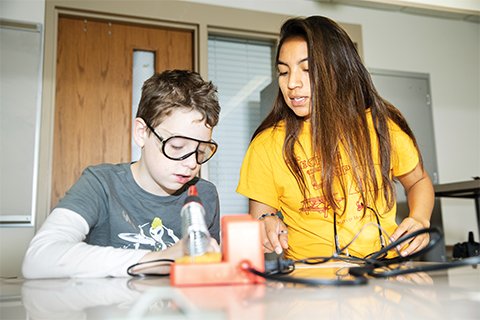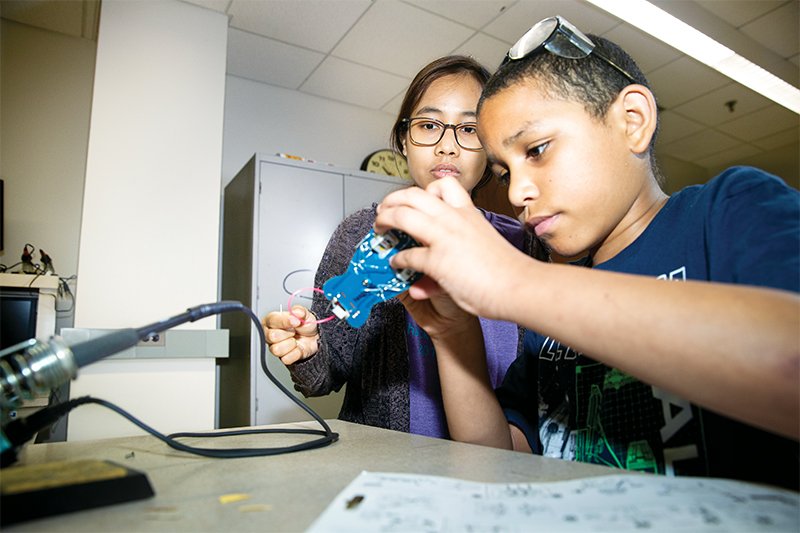Driven to Educate

Above: Each year, Tech Camp welcomes hundreds of children, ages 11 to 13, with limited access to robotics and engineering activities to the College of Science and Engineering on the Twin Cities campus. Mechanical engineering junior Keila Cortes taught them how to solder circuits last summer.
MnDRIVE student scholars aim to spread a love for— and access to— STEM education
December 4, 2019
With the rising profile of youth organizations, like FIRST Robotics, and STEM programs in schools, access to science education and careers is increasing. The College of Science and Engineering (CSE) is doing its part as well.
Each year, CSE’s K–12 outreach events, enrichment programs, and summer camps reach about 50,000 youth.
In addition to annual favorites that draw masses from all walks of life—such as Physics Force, Energy & U, and rotating activities at the Minnesota State Fair—the college is home to the little known MnDRIVE Scholars program that’s teaching children and teenagers more about robotics.
We spoke with CSE students Dario Canelon, Geneva Doak, Dat Nguyen, and Laura Irvine about the importance of STEM outreach and why they chose to become MnDRIVE Scholars.
Scout robots and more
Learning about mathematical equations may not initially pique the interest of many kids, but when Dario Canelon pulls out the robots, eyes light up.
The mechanical engineering graduate student is a Minnesota’s Discovery, Research, and InnoVation Economy (MnDRIVE) Scholar, and he spends his free time teaching middle school students about robotics.
One of Canelon’s jobs is to give local schools tours of the University of Minnesota’s Gemini-Huntley Robotics Research Labs, where he shows young children everything from the world’s smallest solar-powered, unmanned aerial vehicle to diving robots used to collect algae samples from lakes.
The visiting students even get to drive some of the Scout robots, which are tiny, wheeled reconnaissance vehicles used by SWAT teams to scope out buildings before entering.
“We try to make them see that there’s a path to cool things along the way,” explained Canelon, who has been involved in MnDRIVE since 2015.
“Science isn’t all just dry math,” Canelon said.
MnDRIVE is a partnership between the University and the state of Minnesota designed to further research in five main areas: robotics, global food, environment, brain conditions, and cancer clinical trials.
STEM outreach and education are also huge parts of the collaboration, and that’s where MnDRIVE’s Robotics, Sensors, and Advanced Manufacturing division—housed in the University of Minnesota’s College of Science and Engineering—excels.
Students like Canelon, who apply for a MnDRIVE Scholars undergraduate or graduate assistantship position, work closely with local schools and community groups to plan, run, and improve on interactive activities that give youth a creative space to explore robotics and programming.
Encouraging underrepresented groups
Above anything, the MnDRIVE outreach programs are meant to bring science and technology to kids who would not have otherwise had the chance to learn about those fields.
Canelon, a recipient of CSE’s Mechanical Engineering Fellowship, is originally from Venezuela and moved to Minneapolis after his family immigrated to Minnesota in 2007. He said he works with a lot of kids who are first-generation immigrants themselves, or whose parents didn’t attend college.
“You come to a new country, and it’s completely different from where you’re from,” Canelon said. “There are all these activities like Lego robotics, but maybe your parents didn’t even know about them."
"You see kids that come into the camps with low confidence levels, and then by the time they’re done you see a big change in that," Canelon said.
Another issue is the lack of resources in smaller metro area schools.
Students who attend larger, suburban schools with more funding for STEM programs are more likely to be exposed to science, while other students might not be.
Canelon said if they aren’t immersed in these fields in grade school, they’re less likely to pursue careers in science and technology.
“Not everybody has to go to college, and not everybody has to do STEM,” he said.
“But letting these kids know that they’re not less capable than anyone else is the most important thing,” Canelon explained.
Biomedical engineering graduate student and fellow MnDRIVE Scholar Geneva Doak agrees.
A Tennessee native, Doak has been involved with MnDRIVE outreach for about five years. She said that when she was growing up, she didn’t realize the breadth of opportunities available in science and engineering.
“I thought if you liked science, you became either a nurse or a science teacher,” she explained.
“While those are both important and rewarding jobs, there are other options. It’s important to help people understand what opportunities exist.”
MnDRIVE also puts an emphasis on bringing more women into science and engineering by hosting coding camps, after-school STEM activities, and technology day camps geared toward middle school and high school girls.
Confidence stems from enthusiasm
In addition to providing access to science, MnDRIVE Scholars aim to generate a genuine excitement for the subject, whether that means letting students explore the virtual reality cave in Nils Hasselmo Hall or designing a mini robot race tournament.
This also means that they spend a lot of time creating new ways to make STEM concepts fun and understandable for young students.
Last year for example, after a group of middle-schoolers grew bored with the standard computer science concept of Scratch programming, the MnDRIVE Tech Camp introduced “squishy circuits,” or a means to conduct electricity using Play-Doh instead of soldered metal.
Doak said one of the most rewarding parts of outreach is seeing students’ light switches flick on when they realize how to solve a problem.
“Kids will come in and say ‘I can’t do this. I’ve never done this,’” Doak said.
“And then once they get it, you can see the aha moment and they get really excited about it,” she added.
MnDRIVE tech camps also use Ozobots, pocket-sized robots used to teach basic coding, and Arduino boards, which are programmable circuit boards.
Show—and let them play
Dat Nguyen, a senior computer engineering major and undergraduate MnDRIVE Scholar, helped create a mathematical thinking game using the Arduino.
“I could see them get passionate about a subject like math that they had not been passionate about before,” Nguyen said. “A lot of these kids don’t have access to these tools, so by showing them, it introduces them to new ideas.”
According to Canelon, it’s all about getting the students to ask questions and turn on their curiosity.
“Then, they’ll ask you about things you’ve never even thought before,” he said.
Exhibit A: Wondering why the trilobe wheels on a Loper robot look like fidget spinners—something Canelon said, while trivial, had never crossed his mind.
More importantly, he said this newly developed enthusiasm for STEM usually leads to increased confidence in the students.
“It goes from being something dry to being something fun,” he said. “It’s a cool thing when you see kids leave with a more empowered mindset.”

Pass on what you learn
Excitement regarding STEM is something with which Laura Irvine is very familiar.
The MnDRIVE Scholar uses competition robots from the University of Minnesota Robotics student group to give hands-on demonstrations to visiting school groups.
“Being a STEM major and robotics student, I often take a lot of the cool things we do for granted,” said Irvine, a mechanical engineering senior.
“So, seeing how something so simple as a robot shooting a basketball can amaze a young student is eye-opening,” she said.
While most of these demonstrations occur on the Twin Cities campus, MnDRIVE Scholars are also tapped to crisscross the metro area to work with STEM programs in local schools, neighborhood organizations like the Brian Coyle Teen Tech Center, and youth groups such as Urban 4-H and Girl and Boy Scouts.
A large part of this local outreach consists of mentoring students through FIRST (For Inspiration and Recognition of Science and Technology), a national organization that facilitates robotics competitions in which students build robots to complete designated tasks.
A recipient of the college’s PTC/FIRST scholarship, Irvine has been involved in FIRST robotics since high school, and now she helps mentor FIRST Robotics Competition and FIRST Tech Challenge teams around the Twin Cities area, both at practice and at the competitions themselves.
“It’s a lot of fun to see what these kids come up with to solve the challenges each year,” Irvine said. “Often if a team is struggling, three or four other teams are already over there trying to figure out what’s not working before I even step in to help.”
“It’s great to see this at a young age because these are the kinds of behaviors that will get them far in the engineering world," Irvine said.
Irvine said she enjoys giving back to some of the programs that shaped her own love for STEM—and seeing so many of the students she’s worked with apply to STEM programs or robotics groups in college. Plus, she’s inspired to keep the cycle going.
The payoff—mentoring the next generation
“The best thing to hear is when the [high school students] say they want to come back and volunteer just like us, so they can make an impact on a younger student the way we impacted them,” she said.
This notion of paying it forward motivates the other MnDRIVE Scholars as well.
While each one receives either a fellowship or a stipend, all agree that their job is enticing because of the chance to give back and spread a love for science and engineering.
“The program allows me to share my love for the STEM field with a younger generation,” Nguyen said.
“Being able to show these kids a whole new world,” he added, “and watching them show interest in it as I once did is very rewarding.”
Being paid is a bonus, Canelon said, but the work is the real reward.
“At the end of the day, you’re doing something that you do for good reasons,” he said. “It lets you take a step back and look at why you’re doing this and why it’s important.”
Doak agrees, adding that their work can even end up changing someone’s career path. She recently ran into a student she had taught at MnDRIVE Tech Camp who had joined her high school robotics team and now wanted to pursue programming because of Doak’s mentorship.
“You see that you’re helping people in real time,” Doak said.
“It’s those kinds of things that make you feel like you’re making a difference," she added.
Written by Olivia Hultgren
